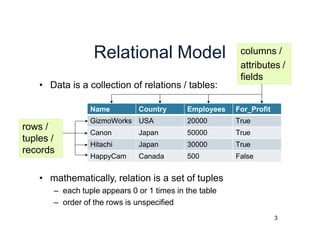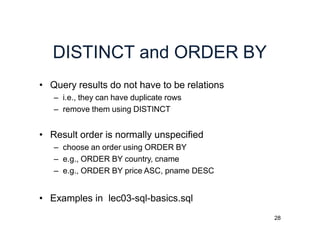lec02-data-models-sql-basics.pptx
- 1. Introduction to Database Systems Lecture 2: Data Models & SQL (Ch. 2.1-2.3) 1
- 2. 2 Data Models • language / notation for talking about data • models we will use: – relational: data is a collection of tables – semi-structured: data is a tree • other models: – key-value pairs: used by NoSQL systems – graph data model: used by RDF (semi-structured can also do) – object oriented: often layered on relational, J2EE
- 3. Relational Model • Data is a collection of relations / tables: • mathematically, relation is a set of tuples – each tuple appears 0 or 1 times in the table – order of the rows is unspecified Name Country Employees For_Profit GizmoWorks USA 20000 True Canon Japan 50000 True Hitachi Japan 30000 True HappyCam Canada 500 False columns / attributes / fields rows / tuples / records 3
- 4. 4 Relational Schema • Each column has a “domain” (or type) – SQL has Java-like types for numbers, strings, etc. – domain is a constraint on the data allowed in the table • Names and types part of the “schema” of the table: Company(Name: string, Country: string, Employees: int, For_Profit: boolean) • Particular data is an “instance” of that relation – data changes over time – DBMS usually just stores the current instance
- 5. 5 Keys • Key = subset of columns that uniquely identifies tuple • Another constraint on the table – no two tuples can have the same values for those columns • Examples: – Movie(title, year, length, genre): key is (title, year) – what is a good key for Company? • Part of the schema (book notation is underline): Company(Name: string, Country: string, Employees: int, For_Profit: boolean)
- 6. 6 Keys (cont.) • Can have multiple keys for a table • Only one of those keys may be “primary” – DBMS often makes searches by primary key fastest – other keys are called “secondary” • “Foreign key” is a column (or columns) whose value is a key of another table – i.e., a reference to another row in another table
- 7. 7 SQL (“sequel”) • Standard query language for relational data – used for databases in many different contexts – inspires query languages for non-relational (e.g. SQL++) • Everything not in quotes (‘…’) is case insensitive • Provides standard types. Examples: – numbers: INT, FLOAT, DECIMAL(p,s) • DECIMAL(p,s): Exact numerical, precision p, scale s. Example: decimal(5,2) is a number that has 3 digits before the decimal and 2 digits after the decimal – strings: CHAR(n), VARCHAR(n) • CHAR(n): Fixed-length n • VARCHAR(n): Variable length. Maximum length n
- 8. 8 SQL (“sequel”) – Cont. • Provides standard types. Examples: – BOOLEAN – DATE, TIME, TIMESTAMP • DATE: Stores year, month, and day values • TIME: Stores hour, minute, and second values • TIMESTAMP: Stores year, month, day, hour, minute, and second values • Additional types differ by vendor: – SQLite: http://www.sqlite.org/datatype3.html
- 9. 9 SQL statements • create table … • drop table ... • alter table ... add/remove ... • insert into ... values ... • delete from ... where ... • update ... set ... where ... • select … from … where
- 10. 10 create table … CREATE TABLE Company( name VARCHAR(20) PRIMARY KEY, country VARCHAR(20), employees INT, for_profit CHAR(1));
- 11. 11 Multi-column Keys • This makes name a key: CREATE TABLE Company( name VARCHAR(20) PRIMARY KEY, country VARCHAR(20), employees INT, for_profit BOOLEAN); • How can we make a key on name & country?
- 12. Multi-column Keys • Syntax change if a primary key has multiple columns: CREATE TABLE Company( name VARCHAR(20) PRIMARY KEY, country VARCHAR(20), employees INT, for_profit BOOLEAN, PRIMARY KEY (name, country)); goes away added 12
- 13. Multi-column Keys (2) • Likewise for secondary keys: CREATE TABLE Company( name VARCHAR(20) UNIQUE, country VARCHAR(20), employees INT, for_profit BOOLEAN, UNIQUE (name, country)); goes away added 13
- 14. Multi-column Keys (3) • This makes manufacturer a foreign key: CREATE TABLE Product( name VARCHAR(20), price DECIMAL(10,2), manufacturer VARCHAR(20) REFERENCES Company(name)); good idea to include target column name 14
- 15. Multi-column Keys (3) • Similar syntax for foreign keys: CREATE TABLE Product( name VARCHAR(20), price DECIMAL(10,2), manu_name VARCHAR(20), manu_co VARCHAR(20), FOREIGN KEY (manu_name, manu_co) REFERENCES Company(name, country)); now need both name & country added 15
- 16. 16 UNIQUE • PRIMARY KEY adds implicit “NOT NULL” constraint while UNIQUE does not – you would have to add this explicitly for UNIQUE: CREATE TABLE Company( name VARCHAR(20) NOT NULL, … UNIQUE (name)); • You almost always want to do this (in real schemas) – SQL Server behaves strangely with NULL & UNIQUE – otherwise, think through NULL for every query – you can remove the NOT NULL constraint later
- 17. 17 drop table ... DROP TABLE Company;
- 18. 18 alter table ... add/remove ... ALTER TABLE Company ADD CEO VARCHAR(20);
- 19. 19 insert into ... values ... INSERT INTO Company VALUES ('GizmoWorks', 'USA', 20000, 'y');
- 20. 20 One Way to Input Data • Write a program that outputs SQL statements: for (int a = 1; a <= 50; a++) for (int b = 1; b <= 50; b++) System.out.format( “INSERT INTO T VALUES (%d,%d);n“, a, b); • Feed those into SQLite: sqlite3 foo.db < inputs.sql
- 22. Warning • Be very careful when doing this with strings: System.out.format( ”INSERT INTO T2 VALUES (%d, ‘%s’);”, 3, ”O’Shaughnessy”); Becomes: INSERT INTO T2 VALUES (3, ‘O’Shaughnessy’); which is a syntax error in this case 22
- 24. 24 Warning (cont) • Be very careful when doing this with strings: System.out.format( ”INSERT INTO T VALUES (%d, ‘%s’);”, 3, ”O’Shaughnessy”); • This allows a SQL injection attack! – Must check for quotes and escape (or disallow) them. – We’ll see safer ways to do this using JDBC • DBMSs usually have faster ways to input data – SQLite has .import (try with .mode csv)
- 25. 25 delete from ... where ... DELETE FROM Company where name = 'GizmoWorks';
- 26. 26 update ... set ... where ... UPDATE Company SET employees = employees + 120 where name = 'GizmoWorks';
- 27. 27 select ... from ... where ... SELECT * FROM Company where name = 'GizmoWorks';
- 28. 28 DISTINCT and ORDER BY • Query results do not have to be relations – i.e., they can have duplicate rows – remove them using DISTINCT • Result order is normally unspecified – choose an order using ORDER BY – e.g., ORDER BY country, cname – e.g., ORDER BY price ASC, pname DESC • Examples in lec03-sql-basics.sql
- 29. 29 Demo on Sqlite • E.g., type sqlite3 in Cygwin • .exit - exit from sqlite3
- 30. 30 SQLite Uses • SQLite is just a library • Can be used as part of any C/C++/Java program – ex: could be used in an iPhone app • Can be used in Chrome & Safari – no support in Firefox or IE
- 31. 31 Physical Data Independence • SQL doesn’t specify how data is stored on disk • No need to think about encodings of data types – ex: DECIMAL(10,2) – ex: VARCHAR(255) • does this need to use 255 bytes to store ‘hello’? • No need to think about how tuples are arranged – ex: could be row- or column-major ordered – (Most DBMSs are row-ordered, but Google’s BigQuery is column-oriented.)
- 32. 32 SQLite Gotchas • Allows NULL keys – At most one tuple can have NULL in the key – According to the SQL standard, PRIMARY KEY should always imply NOT NULL, but this is not the case in SQLite • Does not support boolean or date/time columns • Doesn’t always enforce domain constraints! – will let you insert a string where an INT is expected • Doesn’t enforce foreign key constraints by default • Etc…































